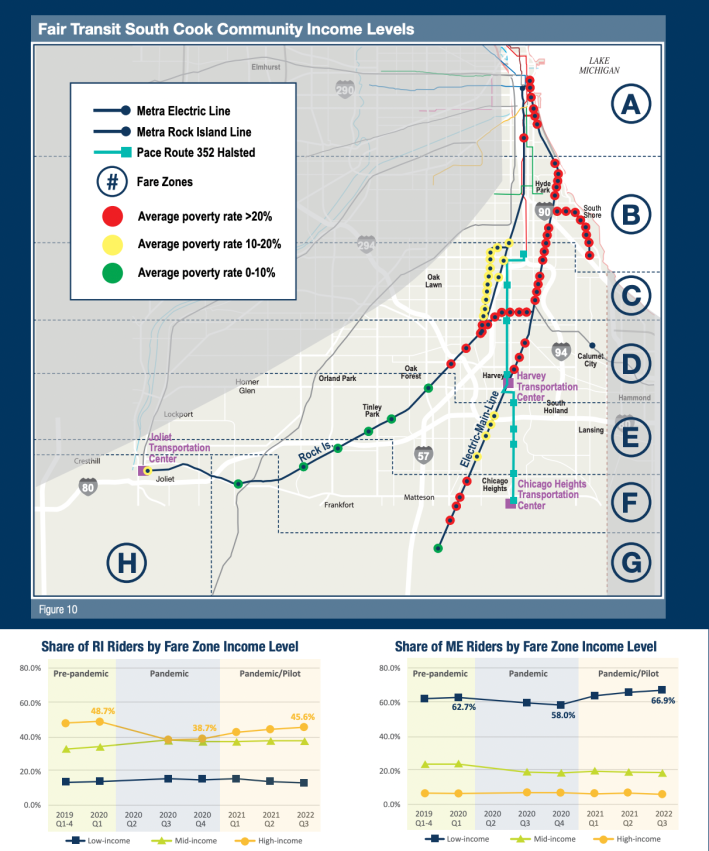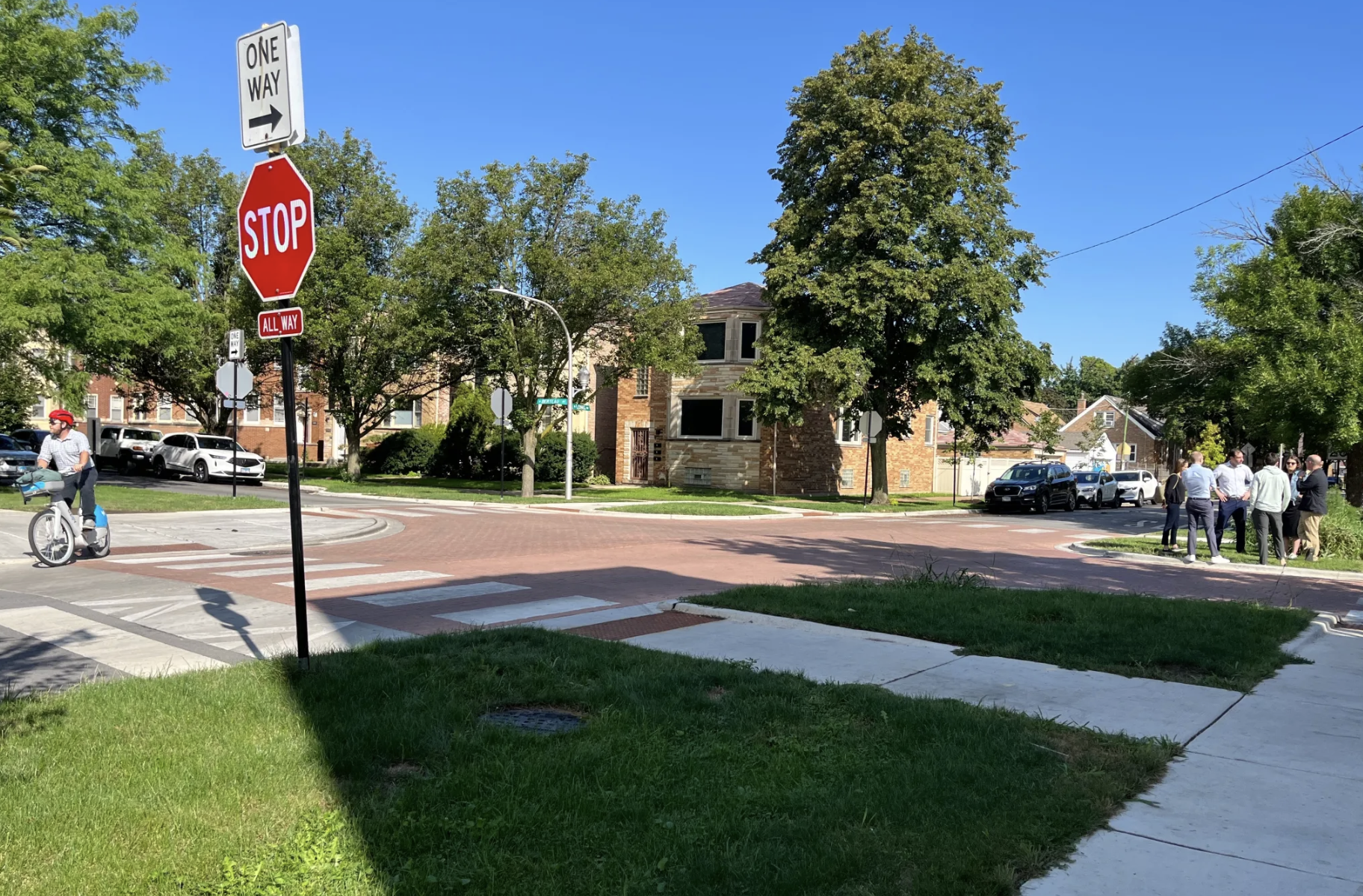Cook County’s report on the first full year of the Fair Transit South Cook reduced fare pilot on the Metra Electric District and Rock Island District lines confirmed some of what Streetsblog Chicago’s earlier dive into Metra ridership numbers suggested. The pilot didn’t increase ridership compared to pre-pandemic levels, but it did help the ridership recover faster from the pandemic lows.
The three-year pilot, which launched at the start of 2021, made the regular MED and RID fares the same as the reduced fares, so that trips within Chicago city limits sometimes actually cost less than a $2.50 CTA ‘L’ ride. The Metra pilot also included increasing service along Pace Route 352, which serves Halsted Street between the 95th/Dan Ryan Red Line station and the Chicago Heights Transportation Center, with transfers to the MED’s main line and its Blue Island branch. While the pilot was conceived well before the pandemic, Cook County, which spearheaded the initiative, decided to proceed with the pilot even as ridership fell significantly below pre-COVID levels.
As we’ve previously reported, the pandemic boosted the MED and RID lines' ridership share, but the pilot didn’t seem to change the situation much one way or another. However, the report concluded that the pilot helped the two lines recover from the COVID slump faster than other lines. The benefits of the reduced fares for low-income residents seem to be a mixed bag. While they initiative seems to have encouraged more working-class residents to ride the Metra Electric, the share of blue-collar residents riding RID actually went down since the pilot.
Metra
MED and RID have more stations within the city of Chicago than any other Metra lines, providing rail service in several areas the ‘L’ system doesn’t reach, and they serve some of the most transit-dependent populations in the Chicago area. All Metra lines saw service cuts at the start of the pandemic, but the system's weekend schedules were restored about mid-way through the pilot, and weekday service came closer to pre-pandemic levels during that time.
As we’ve previously reported, MED’s and RID’s share of total Metra ridership jumped at the start of the pandemic, and while it went through a few swings, the ridership share remained above pre-pandemic levels until the end of 2021. The pilot caused a brief increase in these two lines' ridership share, but otherwise the lower fares didn’t seem to have much of an effect.
But the Cook County report also looked at recovery rates, comparing the current monthly ridership to the same month in 2019, before the pandemic. The study found that the MED and RID recovery rate was already 12 percent higher than the system average at the start of the pilot, and it has climbed to 20 percent of the system average since the pilot started.
Since one of the major objectives of the pilot was to make transit more accessible by making it more affordable, the report also looked at how the ridership levels changed based related to the average incomes of neighborhoods and suburbs. The report acknowledged there is some ambiguity. The study looked at ridership by fare zone, and for the MED Fare Zone B includes more well-off communities like Hyde Park and Kenwood, plus more working-class communities such as Grand Crossing and South Chicago. Nonetheless, the report suggests some tends.
For the RID, since the pilot was introduced, the more well-off communities’ share of the line's ridership went up from 38.7 percent to 45.6 percent, while the working-class communities’ share of ridership dropped slightly, and middle-class communities’ share remained relatively steady. For the MED, where stations serving lower-income communities accounted for more than 50 percent of ridership even before the pandemic, the pilot led to the share increasing from 58 percent to 66.9 percent.
Pace
Route 352 was Pace’s busiest route before the pandemic, and it has been the only route to provide regular night service throughout COVID, since Pace didn’t reduce its service level. Before the Fair Transit South Cook pilot, most of the trips only went as far south as the Harvey Transportation Center, but the pilot beefed up service further south to Chicago Heights, so the buses run until 1:00 a.m. instead of only until midnight. Pace also increased rush hour service frequency from every half hour to every 10 minutes, increased off-peak service from once every 30-60 minutes to once every 15-30 minutes, increased Saturday service from once every 30 minutes to once every 15-20 minutes, and increased Sunday services from one or two buses an hour to two buses an hour.

Similar to the MED and RID, Route 352’s share of Pace's total bus ridership jumped during the stay-at-home order, going from 6 percent to 9 percent. As restrictions relaxed, it dropped back to 6 percent and stayed there through the first two months of the pilot, only to drop to 5 percent from March 2021 onward. The report speculated that with schools returning to in-person learning, the routes with special high school service got the greater share of the ridership.
Unlike the Metra Lines, Route 352’s ridership recovery rate stayed close to the system average. While the rate went slightly above the system average in the first few months of the pilot, by the summer of 2021, it started to slightly decline, even as the system average climbed. And ridership by income level wasn’t entirely conclusive. As the report noted, most of the route serves lower-income communities. Ridership in communities with a 40-50 percent poverty rate went up slightly since the pilot launched, but it declined in all other categories.
"This contrasts with the rest of the Pace system, [where] ridership grew in lower-poverty areas and decreased where poverty rates are higher," the report stated. "While somewhat ambiguous, these results suggest that the lowest-income riders have responded most strongly to the service expansion on Route 352."
The report also looked at the household spending within the entire pilot area and compared it to spending elsewhere in the Chicago area, looking at how much residents spent on car/taxi/ride-hail related expenses and found that residents within the pilot area spent around 3 percent less than residents outside of it.
In their statements in the wake of the report’s release, county and transit officials focused on the fact the pilot contributed to faster ridership recovery and helped lower-income communities. Cook County Department of Transportation and Highways superintendent Jennifer Killen touted the pilot as a way to make the transit system more equitable. "By making transit more affordable and accessible for south Cook residents traveling to their jobs, schools or for recreation, we are bringing inclusivity to the region’s economy," she said.
Metra executive director Jim Derwinski said he appreciated the funding Metra got from the county, and argued that pandemic made the pilot all the more important. "We could not be happier to be working with the County and Pace to provide reliable and affordable transportation to essential workers and other residents of the South Side and south suburbs."
Pace executive director Melinda Metzger said her agency was pleased enough how the pilot turned out to agree to make the Route 352 service expansion permanent. "Pace is grateful for Cook County President Preckwinkle’s investment in public transportation and for our partners at Metra. Together, we have made transportation to employment, education and medical care equitable, reliable, affordable and convenient for the residents of southern Cook County."







